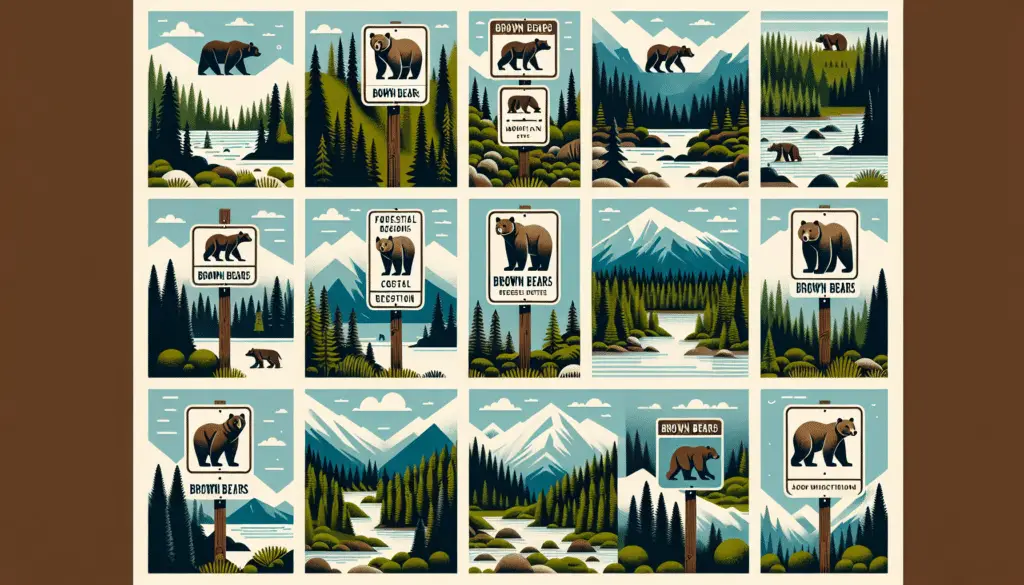Understanding Brown Bears and Their Habitats
Brown bears are one of the most widely distributed large carnivores on Earth, with a presence in North America, Europe, and Asia.
They occupy a variety of habitats, including tundra, forests, mountain areas, and even semi-deserts, demonstrating remarkable adaptability.
The American Brown Bear Distribution
The American brown bear, often referred to as the grizzly bear, thrives predominantly in Alaska and western Canada, with a few isolated populations in the Northwestern United States.
Their numbers in the contiguous US are limited compared to the northern populations, where they have expansive habitats with fewer human disturbances.
Alaska: A Haven for Brown Bears
Alaska is renowned for having the most substantial population of brown bears in the United States, estimated to be over 30,000 individuals.
The vast expanse of wilderness, abundant food sources, and the state’s conservation efforts have made it a haven for brown bear populations.
Prime Brown Bear Locations in Alaska
Renowned for its extensive brown bear habitat, the state boasts several areas where these majestic creatures can be observed in their natural environment.
Katmai National Park and Preserve, Admiralty Island, and Kodiak Island are among the most famous locations frequented by both brown bears and wildlife enthusiasts.
Brown Bear Conservation Status
Despite their healthy numbers in Alaska, brown bears are listed as a species of least concern by the IUCN, but they still face threats from habitat loss and conflicts with humans in other parts of their range.
Conservation measures have been implemented to protect these keystone species and maintain the ecological balance in their habitats.
Where Else Are Brown Bears Found?
Aside from Alaska, brown bears can also be found in western Canada and in several western states of the US like Wyoming, Montana, and Washington, where populations have been recovering due to successful conservation efforts.
The presence of brown bears in these areas is essential as they play a vital role in ecosystem health and diversity.
Understanding the Role of Brown Bears in the Ecosystem
As apex predators, brown bears have a significant influence on the ecosystem, controlling the populations of other animals and even affecting vegetation through their feeding habits.
They also contribute to nutrient cycling by transporting salmon from streams into the forests, thus fertilizing plant life and supporting a diverse range of other species.
Observing Brown Bears in Their Natural Habitat
If you’re looking to observe brown bears in the wild, there are guided tours and viewing platforms in many of these states, particularly in Alaska, which provide safe and respectful opportunities to witness these animals.
It is crucial to always maintain a safe distance and follow park regulations to ensure the safety of both the animals and humans.
Photography Equipment for Bear Watching
For those interested in photographing these bears, a high-quality camera with a telephoto lens is recommended to capture detailed images while maintaining a safe distance.
Based on reviews, the Canon EOS-1D X Mark III is a highly regarded camera for wildlife photography, providing exceptional autofocus, fast shooting speeds, and high image quality even in low light conditions.
Best Practices for Brown Bear Encounters
When in brown bear territory, it is essential to be aware of bear behavior and to practice bear safety.
Carrying bear spray, making noise when hiking, and storing food properly are all critical steps in preventing unwanted bear encounters.
Bear-Resistant Products on the Market
For those spending time in bear country, investing in bear-resistant containers and coolers can be a smart move.
The YETI Tundra series, for example, offers robust and reliable coolers that are certified bear-resistant when used with the appropriate locks, keeping your food safe and reducing the risk of attracting bears to your campsite.
Bear-resistant food containers such as the BearVault BV500 are also a popular choice among backpackers and campers in bear-populated areas.
Find This and More on Amazon
How Climate Change Affects Brown Bears
Climate change is impacting brown bear habitats, with warming temperatures altering ecosystems and food availability.
Brown bears may have to adapt to a changing environment, and there’s a chance that their range could expand or contract with these environmental shifts.
Frequently Asked Questions About Brown Bears
What do brown bears eat?
Brown bears have a diverse diet that includes berries, nuts, leaves, roots, and small to large mammals, and they are also known to fish for salmon in rivers.
Can you see brown bears outside of Alaska?
Yes, brown bears can also be seen in western Canada and various US states such as Wyoming, Montana, Idaho, and Washington.
Are brown bears dangerous to humans?
Brown bears generally avoid human contact, but they can be dangerous if surprised, threatened, or if humans come between a mother and her cubs.
What is the best time of year to observe brown bears?
The best time to observe brown bears in Alaska and other northern regions is in the summer months, particularly from June to September when they are most active.
How can you stay safe in brown bear country?
To stay safe, travelers should make noise when hiking, carry bear spray, maintain a safe distance, and follow guidelines for food storage and camp safety.
Protecting the Future of Brown Bears
Conservation initiatives such as protected areas, wildlife management policies, and public education programs are key to ensuring the future of brown bear populations across the United States.
By understanding and respecting these magnificent creatures and their habitats, we can help preserve them for future generations to marvel at and learn from.


